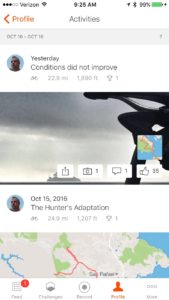What Strava and Foreflight can learn from each other
|
Strava and Foreflight have pursued slightly different strategies. It’s interesting to compare them. Although I’m reluctant to make any recommendations to either of these successful and thriving businesses, I think that Strava could benefit from adopting elements of Foreflight’s rapid innovation and “fanatical pilot support”, and Foreflight might be improved by adding some of Strava’s social elements. A Primer – What’s Foreflight? What’s Strava?
Strava now has over 17 million users (!). My research suggests that they have about 2.5 million active users and a few hundred thousand premium users, who pay $60 per year for enhanced services. Strava has 100 employees and has raised tens of millions of venture capital funding. Strava is going for growth. The free version of the service is very robust so only the most avid users subscribe for premium features.
Foreflight does a lot more than that – it provides crucial weather information, flight planning, notice of legal restrictions, airport diagrams, communication frequencies, and countless other features. Basically, if you say to yourself, “Gee, it would be useful if Foreflight allowed you to ______” you can be pretty sure that Foreflight already has that feature. It’s amazing. It’s even more amazing when one realizes that Foreflight is operating in a highly regulated and bureaucratic business with government agencies as the source of much of their data and huge legal and liability risks. AND pilots tend to older and somewhat scornful of new technology. I know less about Foreflight than I do about Strava, but they launched around 2007, have around 30 employees, are based in Texas (farther from the VC/tech epicenter than S.F.’s Strava) and raised some venture money in 2014. A Foreflight subscription costs $100 per year (and believe me, it’s worth it.) The company doesn’t release subscriber info but I know few active pilots who don’t have it. There are half a million pilots in the U.S., maybe a million in the world, so I’d guess there are maybe 300,000 to 500,000 Foreflight users. Interestingly, Foreflight only works fully on Apple devices, there’s a limited Android offering. This doesn’t seem to be a huge issue because most pilots buy a dedicated iPad that they use primarily for flying and use their iPhone, if they have one, as a backup. Here’s a key difference between Strava and Foreflight – the number of pilots is shrinking. Foreflight has huge share in a shrinking market (maybe innovations like Foreflight that make flying easier and safer will reverse this trend). Strava has only scratched the surface of active sports participants. Strava is used by a large portion of amateur racers and enthusiasts, but is less common among casual cyclists and is less pervasive among runners and other sports. So Strava’s relatively large staff seems focused on sales, marketing, and growth, while Foreflight’s team pushes hard to innovate and improve its product. What Foreflight could learn from Strava This information is already passed around informally in pilot’s lounges, airports, and hangars but the network is limited. Granted there are some scary legal issues involved in posting and sharing GPS routes of every flight. What if the GPS track reveals that a pilot inadvertently violated a minimum altitude requirement, for example? But Foreflight seems to have managed more fraught legal issues than this one. The social aspect of Strava has done a lot to promote cycling, perhaps it could do the same in aviation. What Strava could learn from Foreflight Strava’s creative and hardworking team will object to this observation and point out innovations like heat maps, route planning, photo integration, and other features, but to a user who’s been with Strava from the start it seems that Foreflight’s breadth of features and pace of innovation exceeds Strava’s, even though Foreflight has 1/3 of Strava’s staff. Tiny third-party Strava-powered sites like Veloviewer and Suffervision show how much innovation can be added by just a single passionate programmer. There are so many things that Strava could do – video integration, ride annotations, real-time rider tracking, location tagging like “bike-friendly coffeeshops”, safety and crash marking, event promotion, training analytics, aerodynamic analysis, weather integration – all things that Foreflight would see as central to their mission of “fanatical pilot support”. If Strava pursued “fanatical cyclist support” a lot of users would convert from free to premium. As a cyclist and a pilot I feel lucky to have Strava and Foreflight, tools that have made me better at these activities and enriched my experience with both. I look forward to the future of both Strava and Foreflight with curiosity and optimism. |
 As an avid cyclist and novice pilot, I’ve struck by the similarities and differences between Strava and Foreflight. Both are GPS-based subscription services that were launched less than a decade ago and have become pervasive and powerful. Both have been helped by the the rise of the iPhone and the iPad. Both have complicated relationships with Garmin. Both are excellent companies full of passionate people making something that they love better for everyone.
As an avid cyclist and novice pilot, I’ve struck by the similarities and differences between Strava and Foreflight. Both are GPS-based subscription services that were launched less than a decade ago and have become pervasive and powerful. Both have been helped by the the rise of the iPhone and the iPad. Both have complicated relationships with Garmin. Both are excellent companies full of passionate people making something that they love better for everyone. Strava
Strava Foreflight
Foreflight